
Posted: 28 January
D+I Part of Capgemini (D+I) for Navi Medical Technologies
Design can change lives. And when those lives are tiny, the impact is even greater.
The Head of D+I Part of Capgemini Melbourne (D+I) – Rod Wiebenga has been heavily involved with the Victorian MedTech sector for many years, both as an industrial designer and a mentor, helping innovators get their products off the ground and realise their commercial potential.
Rod met the Navi Medical Technologies team 7 years ago, when it participated in an Origin Australia MedTech Actuator Program (supported by LaunchVic). He immediately recognised a breakthrough opportunity in the technology the team had invented and agreed to guide Navi through the long process of development and commercialisation.
So began a productive and highly creative partnership that has culminated in the design, manufacture and release of the Neonav ECG Tip Location System – a globally-patented, first-of-its-kind, non-invasive device that provides neonatal and paediatric intensive care units with real-time information on catheter tip location. Based on electrocardiogram (ECG) surveillance technology and advanced proprietary algorithms, Neonav interprets cardiac electrical activity recorded through the catheter’s saline flow to give clinicians confidence that insertion procedures, as well as long-term infusion therapy, can be delivered safely and accurately while minimising risk.
Collaboration Across All Project Stages
The D+I team of specialist designers and engineers facilitated and structured the development of this innovative medical device led by Project Manager and D+I’s Head of Electronics, Blake Fuller. Aligning with Navi’s strategic and regulatory objectives, D+I guided the team to better understand product development processes, from design and engineering to market certification documentation and scaled production, with clear insights into which international markets to focus on and what approvals were needed.
‘Our relationships with our clients aren’t just project specific. We continue to work together beyond the initial product release. Our combined offering – which puts industrial design and usability at the forefront and then progresses products through engineering, hardware and software development – gave Navi greater confidence in our ability to add value and bringNeonav to market,’ Rod commented.
While the Navi research component and fine-tuning of the innovation and technology behind the invention took upwards of 5 years, D+I helped fast-track the design to commercialisation process, which was completed within 18 months.
‘Cross pollination of technology is what we do. Because our portfolio is diverse – covering consumer, commercial and scientific products – we bring the usability approach we’ve implemented with consumer products and apply it to MedTech, giving devices and digital interfaces a more streamlined look and feel with a contemporary sensibility,’ mentioned Blake.
Once the core technology and architecture for the electronics were feasible, the D+I project team focused its attention on the end users – the clinicians, the parents and those who would service the device. Engagement with them and understanding how they would interact with the interface was crucial to Neonav’s potential success.
Central to that stage of development was Navi’s Chief Medical Officer, A/Prof. Christiane Theda, a senior neonatal consultant at the Royal Women’s Hospital and a member of thePaediatric Infant Perinatal Emergency Retrieval (PIPER) team at the Royal Children’s Hospital. Leading the clinical research and supporting the engineering activities for Neonav, she provided D+I with expert insight into what would and wouldn’t work and was instrumental in facilitating clinical trials.
Technical Challenges Inspire Creative Design Decisions
MedTech has its own set of extremely specific parameters that dictate how a device can be designed. A commercial and user experience-approach must be balanced with the functionality of the technology and patient safety in a highly regulated environment, taking into consideration the device’s bio-compatibility. Devices need to be very utilitarian, foolproof, and clinically safe, often with intricate parts.
Neonav had to operate in a controlled, sterile environment and be defibrillation-proof. When designing the user interface, D+I applied a simpler, web-based technology and introduced several smart elements to ensure success.
Going through different iterations of product development was complex as clinicians have a very nuanced and ordered way of working and their requirements needed to be factored into every design element.
Factoring in how it related to the user, how it looked and how it functioned as a mechanical device, initial sketches and an alpha prototype were shared with sector experts. Feedback from clinicians, who were simulating the procedure on dolls, was extensive and led to 100% of the device’s screen pages being changed before the creation of the beta prototype.
Understanding the Human Impact of Medical Devices
User trust and personal experience are paramount to a successful outcome in product design – something that Blake witnessed firsthand whilst working on this project. When his newborn twins required special care, his understanding of medical devices like Neonav made the situation far less daunting.
‘Having been intricately involved in the Neonav project for several years, when it came to my own children, there was some comfort in knowing what to expect. The knowledge I hadgained and the relationships I had built helped me trust the technology and made me less afraid,’ he remarked.
Blake took this experience and injected it into the project, ensuring that the technology wouldn’t be confronting for parents.
Reinventing What Practical Medical Devices Should Look, Sound & Feel Like
The aesthetic of Neonav was designed with patient and family impact in mind. Alarm fatigue (sensory overload where clinicians, especially nurses, can become desensitised to the sheer number of alarm signals, leading to missed alarms or delayed response) is something that many parents, clinicians and patients suffer from – as anyone who has ever spent time in an intensive care unit would know.
The project team chose to purposefully distance itself from conventional medical devices. Neonav operates quietly, has soft, rounded edges, an organic-shaped silhouette rather than a rigid box-like structure, and a powder blue casing.
‘A big part of being environmentally minded is making products that stand the tests of time. With smart design, products are naturally more sustainable in the long run. Although the device is made from plastic (as required for sterility purposes) its design and operation focus on an extended lifecycle which in the case Neonav is upwards of 10 years,’ commented Rod.
‘Traditional catheter insertion often requires several attempts, meaning that each time, new, sterile components are needed, and previous pieces discarded. The accuracy of Neonaveliminates this wastage,’ mentioned Blake.
‘A touchscreen isn’t sterile, so we designed a remote control for use in the sterile field when inserting the catheter and reusable screen covers for the interface to further reduce waste. Wherever possible, we incorporated components that could be easily disassembled for end-of-lifecycle disposal,’ he added.
Victoria’s Reputation for Excellence in MedTech Design and Innovation
The recipients of more than 270 national and international awards – including a 2022 Victorian Premier’s Design Award for its Biorithm device – Rod readily admits that D+I is a ‘serial award enterer.’
‘We are thrilled that the Victorian Premier’s Design Awards chose to recognise our work on Neonav. It’s an important way to showcase product design and sell the message of design. We need successful products that people resonate with, so winning a VPDA is validation of the work we do and demonstrates that designers are a respected and integral part of that process,’ he said.
‘Navi has gone through a big journey. This award is a great platform for getting its name out to a wider community. It’s also an acknowledgement that real people make these things and users benefit, highlighting that human-centric design successfully solves problems. There’san important cycle of human connection throughout the process – from identifying a need and conducting initial patient trials to Neonav’s use in hospitals around the world,’ said Blake.
‘The award is also significant because Victoria is probably in the top 4 centres in the world for developing MedTech devices. My theory is that Melbourne has a strong blend of working hospitals clustered around very high-quality universities, research institutions and alumni networks, who work closely together, integrating their learnings,’ said Rod.
‘But the ‘glue’ that binds them and elevates MedTech is the capability and passion of our people – designers, engineers, regulatory consultants and manufacturing partners across the entire supply chain – who gather around these clusters to accelerate the commercialisation process,’ added Blake.
At the Forefront of Clinical and Commercial Success
When award-winning user-centric design, innovation, medical science, technology and sheer perseverance come together, it can create something of incredible value. In the case of Neonav, the result is a Victorian-developed and Australian-manufactured device that will not only enhance levels of neonatal care around the world but has the potential to be used in a broader range of medical applications to enhance patient outcomes and streamline clinical workflows.
With new usability trials currently underway in the US ahead of regulatory approval* and additional local trials here in Australia, Neonav is well on its way to being a disruptor in the neonatal and paediatric care sectors.
*Neonav is pending 510(k) clearance and is currently not available for sale within the United States.



